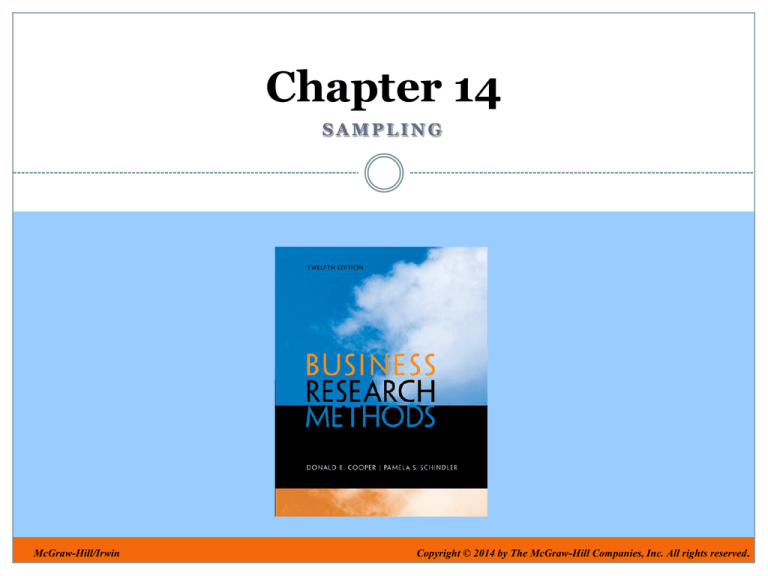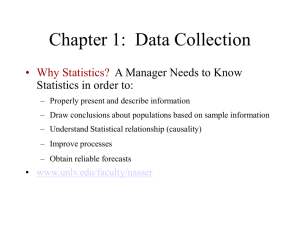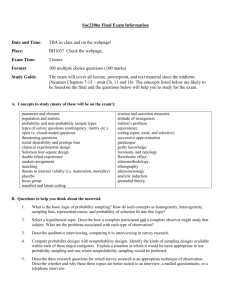
Chapter 14
SAMPLING
McGraw-Hill/Irwin
Copyright © 2014 by The McGraw-Hill Companies, Inc. All rights reserved.
Learning Objectives
Understand . . .
The two premises on which sampling theory is
based.
The accuracy and precision for measuring
sample validity.
The five questions that must be answered to
develop a sampling plan.
14-2
Learning Objectives
Understand . . .
The two categories of sampling techniques and
the variety of sampling techniques within each
category.
The various sampling techniques and when
each is used.
14-3
Pull Quote
“We have to hear what’s being said in a
natural environment, and social media is an
obvious place to do this, but we also have to
go and discover the opinions that are not
being openly shared. Only then can we
understand the dichotomy between the public
and private persona.”
Ben Leet, sales director
uSamp
14-4
The Nature of Sampling
Population
Population Element
Sampling Frame
Census
Sample
14-5
Why Sample?
Availability of
elements
Greater
speed
Lower cost
Sampling
provides
Greater
accuracy
14-6
What Is a Sufficiently Large Sample?
“In recent Gallup ‘Poll on polls,’ . . . When asked
about the scientific sampling foundation on which
polls are based . . . most said that a survey of 1,500 –
2,000 respondents—a larger than average sample
size for national polls—cannot represent the views of
all Americans.”
Frank Newport
The Gallup Poll editor in chief
The Gallup Organization
14-7
When Is a Census Appropriate?
Feasible
Necessary
14-8
What Is a Valid Sample?
Accurate
Precise
14-9
Sampling
Design
within
the
Research
Process
14-10
Types of Sampling Designs
Element
Probability
Selection
•Unrestricted • Simple random
•Restricted
Nonprobability
• Convenience
• Complex random • Purposive
• Systematic
• Judgment
•Cluster
•Quota
•Stratified
•Snowball
•Double
14-11
Steps in Sampling Design
What is the target population?
What are the parameters of interest?
What is the sampling frame?
What is the appropriate sampling
method?
What size sample is needed?
14-12
When to Use Larger Sample?
Population
variance
Number of
subgroups
Confidence
level
Desired
precision
Small error
range
14-13
Simple Random
Advantages
Disadvantages
Easy to implement
Requires list of
with random dialing
population elements
Time consuming
Larger sample needed
Produces larger errors
High cost
14-14
Sample Frame
List of elements in population
Complete and correct
Error rate increases over time
May include elements that
must be screened out
International frames
most problematic
14-15
How to Choose a Random Sample
14-16
Systematic
Advantages
Disadvantages
Simple to design
Periodicity within
Easier than simple
population may skew
sample and results
Trends in list may
bias results
Moderate cost
random
Easy to determine
sampling distribution
of mean or proportion
14-17
Stratified
Advantages
Disadvantages
Control of sample size in
Increased error if
strata
Increased statistical
efficiency
Provides data to represent
and analyze subgroups
Enables use of different
methods in strata
subgroups are selected at
different rates
Especially expensive if
strata on population must
be created
High cost
14-18
Cluster
Advantages
Disadvantages
Provides an unbiased
Often lower statistical
estimate of population
parameters if properly
done
Economically more
efficient than simple
random
Lowest cost per sample
Easy to do without list
efficiency due to
subgroups being
homogeneous rather
than heterogeneous
Moderate cost
14-19
Stratified and Cluster Sampling
Stratified
Cluster
Population divided into
Population divided into
few subgroups
Homogeneity within
subgroups
Heterogeneity between
subgroups
Choice of elements from
within each subgroup
many subgroups
Heterogeneity within
subgroups
Homogeneity between
subgroups
Random choice of
subgroups
14-20
Area Sampling
Well defined political or
geographical boundaries
Low cost
Frequently used
14-21
Double Sampling
Advantages
Disadvantages
May reduce costs if first
Increased costs if
stage results in enough
data to stratify or cluster
the population
discriminately used
14-22
Nonprobability Samples
No need to
generalize
Feasibility
Limited
objectives
Time
Cost
14-23
Nonprobability Sampling Methods
Convenience
Judgment
Quota
Snowball
14-24
Key Terms
Area sampling
Multiphase sampling
Census
Nonprobability
Cluster sampling
sampling
Population
Population element
Population parameters
Population proportion
of incidence
Probability sampling
Convenience sampling
Disproportionate
stratified sampling
Double sampling
Judgment sampling
14-25
Key Terms
Proportionate
Simple random
stratified sampling
Quota sampling
Sample statistics
Sampling
Sampling error
Sampling frame
Sequential sampling
sample
Skip interval
Snowball sampling
Stratified random
sampling
Systematic sampling
Systematic variance
14-26
Chapter 14
ADDITIONAL DISCUSSION OPPORTUNITIES
McGraw-Hill/Irwin
Copyright © 2014 by The McGraw-Hill Companies, Inc. All rights reserved.
Snapshot: Ford’s New Sample
Dealers control 75% of advertising
Recruited 30 influential dealers
Morpace conducted focus groups
72-hour marathon of questions
Gave voice to important group
14-28
Snapshot:
Research
for Good
14-29
PicProfile: Mixed-Access Sampling
14-30
CloseUp: Keynote Experiment
14-31
CloseUp: Keynote Experiment (cont.)
14-32
Pull Quote
“The proof of the pudding is in the eating.
By a small sample we may judge of the
whole piece.”
Miguel de Cervantes Saavedra
author
14-33
PulsePoint: Research Revelation
80
The average number of text
messages sent per day by
American teens.
14-34
Chapter 14
SAMPLING
McGraw-Hill/Irwin
Copyright © 2014 by The McGraw-Hill Companies, Inc. All rights reserved.
Photo Attributions
Slide Source
5 ©Ocean/Corbis
9 Chris Satttlberger/Getty Images
12 Jochen Sands/Getty Images
13 Getty Images
15 KidStock/Getty Images
23 Ryan McVay/Getty Images
24 Photodisc/Getty Images
28 David and Les Jacobs/Blend Images
14-36










